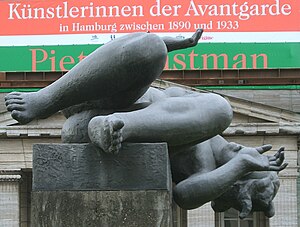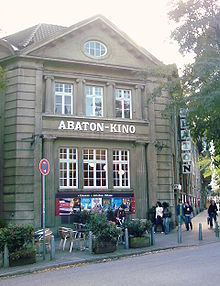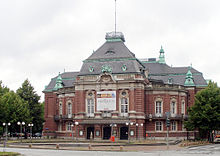Culture in Hamburg
The culture in the Free and Hanseatic City of Hamburg is largely due to the private initiative of its citizens and thrived in its liberal and patronage attitude.
In contrast to other cities of this size, Hamburg could not fall back on the cultural funding of a court in this city or a prince. Rather, the city's cultural life was dependent on the initiative of its citizens. In fact, the city did not pursue any active cultural policy until the 1930s. Existing and established institutions were only financially supported when citizens had made preliminary work and the usefulness was plausible.
Art prizes and honors
Art awards
- Aby Warburg Prize , donated in 1979
- Bach Prize , donated in 1950
- Edwin Scharff Prize , donated in 1955
- Hubert Fichte Prize , formerly the Alexander Zinn Prize
- Karl Schneider Prize , donated in 1985
- Finkenwerder Art Prize , since 2000
- Lessing Prize , donated in 1930
- Lichtwark Prize , donated in 1951
- Silver mask , donated in 1969 by the Hamburger Volksbühne .
Artist honors
- Johannes Brahms Medal : Awarded for outstanding achievements in the field of music, in particular the maintenance of Brahms' work
- Medal for Art and Science : Award for outstanding achievements of lasting value for Hamburg in the fields of research, science or art
- Senator Biermann Ratjen Medal : Award for services to Hamburg through artistic or other cultural achievements
media
theatre
On January 2, 1678, the city theater was inaugurated here as the largest civic baroque opera house, where Georg Friedrich Handel worked as a violinist in the opera orchestra in 1704 . Georg Philipp Telemann directs the opera from 1722 to 1737 . In 1765 the dilapidated opera house is torn down and the German National Theater built, where Lessing takes over the dramaturgical direction for three years on April 22, 1767. In the same year, his Minna von Barnhelm is premiered here.
Speaking platforms
In addition to the state theaters (Schauspielhaus, Staatsoper and Thalia) there are a number of private theaters with their own ensemble and pure guest performance.
- The Fleetstreet in Neustadt is, among other things, a stage for young artists and avant-garde pieces.
- The Istasyon Theater in Altona, founded in 1989 by the Turkish game association Türk Toplumu eV, offers mainly Turkish-language plays, but occasionally also German-language or textless performances.
The Deutsches Schauspielhaus was inaugurated in 1900. Its founding by a private stock corporation can be traced back to models in German princely residences. The painter's hall in the adjacent building is available as an additional stage.
The Thalia Theater looks back on the longest history of the existing speaking theaters ; it was founded in 1842.
The Ohnsorg Theater was founded in 1902 by Richard Ohnsorg as a Low German stage under the name of the Hamburg Dramatic Society . Today the Ohnsorg Theater is a GmbH, owned by the Free and Hanseatic City of Hamburg.
The Imperial Theater is a small , private crime theater founded in 1994 as a music theater .
Comedy Winterhuder Fährhaus is a venue for comedies and tabloids.
The theater in the room was founded in 1948 by Helmuth Gmelin and ceased operations in 1999 under his daughter Gerda Gmelin as principal. In 2004, theater operations were resumed for a few weeks. At the moment, the future of the house as a theater is uncertain.
The theater on Marschnerstrasse is Hamburg's largest amateur theater with almost 300 seats.
The Ernst Deutsch Theater was founded in 1951 by the actors Friedrich Schütter and Wolfgang Borchert .
The Kammerspiele , founded by Erich Ziegel in 1918, developed into a focal point of modern, expressionist theater in the 1920s . The theater was reopened in 1945 under the management of Ida Ehre .
The Harburger Theater resides in the Archaeological Museum Hamburg in Harburg .
The theater for children in the Allee-Theater is a children's theater .
The Altona Theater brings literature to the stage.
Theater with different directions
Some stages offer a mixed program such as speech, dance or music theater, cabaret. A stage with different events is also the tent theater of the flying buildings
Kampnagel is a stage complex in a former factory, which was initially used by the theater, today numerous guest performances and festivals for contemporary performing arts take place here.
The St. Pauli Theater , formerly the Ernst Drucker Theater, founded in 1841 on Spielbudenplatz , is one of the oldest German private theaters and the longest-running (listed) stage in Hamburg.
The Schmidt Theater is a private theater founded by Corny Littmann in St. Pauli. It has two venues, the Schmidt Theater itself and Schmidts Tivoli, which is only a few steps away .
Cabaret and Variety Show
- Hansa-Theater : Of the classic vaudeville houses that still offered a regular program after the Second World War , like Haus Vaterland, only the Hansa-Theater (temporarily) still exists .
- The ship was set up by Eberhard Möbius thirty years ago as a small stage on an inland motor ship and has its berth in Nikolaifleet when it is not on tour.
- Alma Hoppe's Lustspielhaus, founded by the Alma Hoppe duo, sees itself as a cabaret and has had its permanent home in the community center and cinema built in 1927 since 1994.
- Polittbüro : In the former cinema hall ( Neues Cinema am Steindamm) the stage of the cabaret group Herrchens Frauchen ( Lisa Politt / Gunter Schmidt).
Children's theater
- Monsun Theater in Ottensen
- Ottensen Court Theater / Wackelzahn Children's Theater in Hamburg-Ottensen
- Fundus Theater in Eilbek
Opera, ballet, musical
Hamburg is known as the musical capital of Germany. Here is Andrew Lloyd Webber's Cats played for the first time in Germany. In addition, in 2006 ran until January 22, Dance of the Vampires by Roman Polanski successfully in the theater Neue Flora. Current productions include The Lion King , Tarzan and I've never been to New York (musical) .
The Hamburg State Opera traces its history back to the first civil opera on Gänsemarkt , founded in 1678 .
The Neue Flora is operated as a musical theater by Stage Entertainment .
The theater in the harbor is a musical theater opposite the Überseebrücke.
The Opernloft offers musical theater and special opera performances, each tailored for children, young people or adults and opera beginners.
The Operettenhaus is a musical theater with a history.
In the small avenue theater , the Hamburg Chamber Opera mainly offers operas.
The Delphi Showpalast runs musicals and shows that combine food, drink and entertainment.
- The Hamburg Angel Hall on Valentinskamp in Neustadt is a theater of the "light muse" (operettas, musicals, etc.) The only private theater with its own operetta repertoire and philharmonic and hit orchestras in a listed building that was used as a private theater as early as 1809.
movie theater
See also: List of Hamburg cinemas .
Knopf's cinema on the Reeperbahn is one of the first permanent cinemas in Germany, and the first films were shown here around 1900. In the Deutschlandhaus near Gänsemarkt , built in 1929 by the architects Block & Hochfeld, the largest cinema in Europe at the time, the UFA-Palast , was designed by Walther Unruh with 2,667 seats . After the bankruptcy of the operating company and the sale of the property, the UFA Palace, built elsewhere, closed at the end of May 2006 and was demolished. The Passage Kino in Mönckebergstrasse is one of the oldest Hamburg cinemas that is still in operation at the old location. The Grindel in the quarter of the same name was the location of numerous European premieres between 1959 and 1970, thanks mainly to its outstanding technical equipment at the time. It was one of the few cinemas that could show films in the Cinerama format. In 1994 it became Hamburg's first multiplex cinema. After the last performance in March 2008, it was demolished in 2009.
After the closure of the UFA palace, the Cinemaxx Dammtor is the only multiplex cinema in the city center. Further Cinemaxx offshoots were created in Harburg and Wandsbek . Three UCI Kinowelt - multiplexes in Othmarschen , Wandsbek and the Mundsburg make the Cinemaxx cinema competition.
Many of the district cinemas closed their doors in the 1960s and 1970s. Because of the financial problems of the Ufa cinemas , several cinemas had to close in the late 1990s and early 2000s. There are still several art house cinemas where auteur films and English-language films are shown.
Arthouse cinemas
- 3001 cinema
- Abaton
- Alabama cinema
- ASTOR Film Lounge HafenCity
- Blankenese cinema
- B-movie
- CinemaxX at three locations
- Elbe film theater
- Movie room
- fux plays of light
- Hansa film studio Bergedorf
- Holi
- Coral cinema
- Light meas
- magazine
- Metropolis cinema
- Passage cinema
- Savoy movie theater
- SchanzenKino 73
- Studio cinema
- go to cinemas
Film festivals
- Fantasy film festival
- Hamburg Film Festival
- International Short Film Festival Hamburg
- Japan Film Festival Hamburg
- Lesbian and gay film days Hamburg
music
Orchestra and choirs
- Philharmonic State Orchestra Hamburg - The orchestra founded in 1828 was initially called the Philharmonic Concert Society.
- NDR Sinfonieorchester - The orchestra was founded in 1945 as a symphony orchestra of the NWDR and was given its current name in 1955 after the station split into NDR and WDR .
- Hamburger Symphoniker - The orchestra was founded in 1957. Jeffrey Tate is the chief conductor .
- Hamburger Camerata
- Choir Association Hamburg - Individual association of the German Choir Association e. V. He looks after around 100 member choirs in the Hanseatic city and its neighboring communities.
- Choir of the NDR - The choir, founded in 1946, was initially called the Northwest German Radio Choir until 1955. He performs a cappella works from various eras.
- Kodály Choir Hamburg - The amateur choir was founded in 1972 by Fritz Bultmann .
- Monteverdi Choir Hamburg - The amateur choir was founded in 1955 by Jürgen Jürgens and mainly deals with works by the Italian master Claudio Monteverdi .
- Mendelssohnchor Hamburg - founded in 1997, it performs classical-romantic oratorios, but also a cappella programs and works from other musical epochs.
Venues for concerts
- O2 World Hamburg , Bahrenfeld , formerly Color Line Arena
- Congress Center Hamburg (CCH), Neustadt
- Docks , also D-Club , St. Pauli
- Factory , Ottensen
- Friedrich-Ebert-Halle , Heimfeld
- Große Freiheit 36 with Kaiserkeller , St. Pauli
- Grünspan , St. Pauli
- Hafenklang , Altona
- Indra , St. Pauli
- Jazz club in the Stellwerk , Harburg
- Knust , St. Pauli, Karoviertel
- Laeiszhalle , until 2005 Musikhalle , Neustadt
- Logo , Rotherbaum in Grindelwald -Quartier
- Market Hall , Hammerbrook
- Molotow , St. Pauli
- Music seminar Hamburg
- Rote Flora , Sternschanze
- Sports hall Hamburg , Winterhude
- Evil & Dangerous , St. Pauli, Karoviertel
- Zeisehallen , Ottensen
The Elbphilharmonie , a music hall that is due to open in 2017, is under construction .
The Star Club , one of the Beatles' venues alongside Kaiserkeller and Indra , no longer exists. A memorial stone commemorates him. The Ernst-Merck-Halle , formerly one of the few halls in Hamburg suitable for larger concerts, in which the Beatles , Rolling Stones , Who , Queen , AC / DC and many others played, was demolished as part of the renovation of the exhibition grounds.
Popular culture
Hamburg can not only advertise that the Beatles found their origin here. Even today, Hamburg has been known for its lively culture for decades. a. for trends such as the Hamburg School ( Die Sterne , Tocotronic and many more), punk rock ( Slime , Die Goldenen Zitronen ) and Hip Hop ( Beginner , Deichkind , Fettes Brot , Fünf Sterne deluxe , Samy Deluxe ). The political culture that arose from the squatting in Hafenstrasse and the left-wing alternative milieu in the Schanzenviertel district ( Rote Flora , Radio FSK ) since the early 1980s also often had a formative influence on cultural events .
Music festivals
- Wutzrock , the free-and-outside festival has been held in the east of Hamburg since 1979.
- Dockville , the music and art festival, has been taking place in the Wilhelmsburg district near the Elbe and HafenCity since 2007 . The headliners were already well-known German bands such as Deichkind , Fettes Brot , 2raumwohnung and Tocotronic .
- Reeperbahn Festival , the music festival takes place annually for three days at numerous locations around the Reeperbahn.
Festivals
- STAMP, The Street Arts Melting Pot, Hamburg's International Festival of Street Arts, has been celebrated every year since 2010 at the beginning of September around the Große Bergstrasse in Altona .
- Private theater days of the Altona Theater to give an impression of the professionalism and diversity in the German private theater scene
literature
- Literaturhaus on the Alster
- Forum Hamburg Authors
Writer in Hamburg

Quite a few living German writers have or had their place of residence in Hamburg, including: Ralph Giordano , Brigitte Kronauer , Siegfried Lenz and Peter Rühmkorf .
Wolfgang Borchert , Barthold Heinrich Brockes , Willi Bredel , Matthias Claudius , Richard Dehmel , Marion Countess Dönhoff , Hubert Fichte , Gorch Fock , Arno Schmidt , Friedrich von Hagedorn , Christian Friedrich Hebbel , Heinrich Heine , Hans Henny Jahnn , Rudolf were closely connected to Hamburg Kinau , Friedrich Gottlieb Klopstock , Hans Leip , Gotthold Ephraim Lessing , Detlev von Liliencron , Hans Erich Nossack , Carl von Ossietzky .
Honourings and prices
- Biermann Ratjen Medal
- Hamburg Literature Awards
- Hannelore Greve Literature Prize
- Irmgard Heilmann Prize
- Lessing Prize from the Free and Hanseatic City of Hamburg
- Mara Cassens Prize of the Literaturhaus for the first novel
- AstroArt Literature Prize
Libraries
The largest and oldest library in Hamburg is the State and University Library Hamburg Carl von Ossietzky . Today it serves as a general academic library and university library. Its origin was the council library from 1491.
The Commerzbibliothek of the Hamburg Chamber of Commerce was founded in 1735 for the education and training of Hamburg merchants and today has a holdings of more than 170,000 volumes. She specializes in works on economics and business law.
Both libraries were housed in the building of the former Johanneum am Speersort from 1919 until they were bombed in 1943 . During the Second World War, the bombs destroyed large parts of the old stocks.
In many parts of the city there are public bookhouses , which were founded in 1899 by the Patriotic Society .
Visual arts
The roots of today's College of Fine Arts go back to the founding of a school for arts and crafts of the Patriotic Society in 1787. The learning program was geared towards the economic benefits for the production of goods, which today is called industrial design . The Hanseatic city got a training center for the "liberal arts" relatively late with the state art school in the Weimar Republic . Alfred Lichtwark , Hamburg's first art gallery director, complained at the turn of the 19th and 20th centuries that numerous talents left their hometown and never came back because they could not find adequate training opportunities in Hamburg. Women could only take art lessons in expensive private lessons or attend the private art school Valeska Röver (since 1904 Gerda Koppel ). It was only after the First World War that the general situation for fine art began to change for the better. A small, fine collecting community for modern art developed . In 1919, avant-garde artists founded the Hamburg Secession , which in the 1920s was described as the liveliest group of artists in Germany. She saw herself as an "elite group" and as the successor to the expressionist artist group Die Brücke . Right at the beginning of the National Socialist era , the artist community dissolved voluntarily in order not to have to comply with the racist guidelines of the new rulers. A re-establishment after the Second World War failed. However, some of the secession artists were involved in the reconstruction of the then still called State Art School, the University of Fine Arts (HfbK). Friedrich Ahlers-Hestermann , founding member of the Hamburg Secession, headed the reconstruction as director of the state art school. From the class of the former secessionist artist Karl Kluth about who went group Zebra forth. Numerous renowned artists have studied at the HfbK, including Adam Jankowski , who later opened his studio in St. Pauli.
Artist
Patrons, art historians
Ida Dehmel - Harald Falckenberg - Werner Hofmann - Kurt A. Körber - Emmi Ruben - Rosa Schapire - Gustav Schiefler - Luise Schiefler - Aby Warburg - Martin Warnke
Museums
See also: List of museums in Hamburg and the category Museum in Hamburg . Here follows a thematic order, which is not entirely accurate due to numerous overlaps:
History (regional), economy
- Museum of Hamburg History with the branches:
-
Altonaer Museum with the branches:
- Jenisch House
- Rieck House
- Heine House in Heine Park
- Archaeological Museum Hamburg with the branches:
- Alstertal Museum
- Bunker Museum
- Hamburg School Museum
- HSV Museum
- Museum Friedhof Ohlsdorf
- Neuengamme Concentration Camp Memorial
- Volksdorf museum village
- Water art on the Elbe Island Kaltehofe
- Spice Museum
- Ballin City
- German Customs Museum
- Saint Pauli Museum
technology
- Museum of work with the branch offices:
- International Maritime Museum Hamburg
- Museum for Communication (closed in 2009)
- miniature wonderland
- Museum harbor Oevelgönne
- Museum ship Cap San Diego
- Museum ship Rickmer Rickmers
- Museum ship MS Bleichen
- U434 submarine museum
- prototype
- electrum
- Schmidt Museum
Art, trade
- Hamburger Kunsthalle
- Museum of Arts and Crafts
- Museum of Ethnology Hamburg
- Afghan Museum (closed in 2011)
- Bucerius Art Forum
- Ernst Barlach House
- Erotic Art Museum Hamburg (closed in 2007)
- Free Academy of Arts in Hamburg
- Deichtorhallen
- Johannes Brahms Museum
- Art Association Hamburg
- Falckenberg Collection
- Gallery Commeter
- Telemann Museum
science
- German additive museum
- Geological-Paleontological Museum Hamburg
- Loki Schmidt House
- Medical history museum at the University Medical Center Hamburg-Eppendorf
- Mineralogical Museum Hamburg
- SteinZeiten (closed in 2009)
- Hamburg Zoological Museum
Further
- Beatlemania Hamburg (closed in 2012)
- Dialogue in the dark
- Hamburg Dungeon
- Harry's Hamburg Harbor Bazaar
- Panoptikum Hamburg
District culture
Around 2 percent of the budget of the cultural authority goes to promoting urban culture. The Hamburg district culture associations and history workshops are united in the umbrella organization Stadtkultur Hamburg eV. Hamburg has the highest density of district cultural centers in Germany, of which there are more than 25 here. The most famous centers, town houses and history workshops in the city include:
- Barmbeker Association for Culture and Work
- Bramfeld culture shop
- Town house in Barmbek
- Wilhelmsburg community center
- History workshop Barmbek
- Goldbekhaus Winterhude
- GWA St. Pauli with Kölibri
- House three in Altona old town
- Honey factory
- Eppendorf cultural center
- Culture shop St. Georg
- Kulturpalast Billstedt
- Harburg culture workshop
- LOLA cultural center Bergedorf
- Motte in Ottensen
- City district archive Ottensen
Working without official funding among others:
- Red flora
- House of Culture 73
Visitor organizations
Hamburg's largest visitor organization is the Hamburger Volksbühne e. V. It was founded as an association on January 4, 1919 and has over 22,000 members.
The TheaterGemeinde Hamburg was founded in 1984 and has 14,000 members.
Web links
- Kulturkarte.de cultural map of Hamburg with many cultural institutions and sights of the Hanseatic city.
Individual evidence
- ↑ www.monsuntheater.de
- ^ Current - Hoftheater Ottensen - Children's and youth theater. In: www.hoftheater-ottensen.de. Retrieved August 6, 2016 .
- ↑ www.fundus-theater.de
- ↑ www.stamp-festival.eu


































